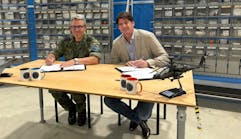Jul. 26—Southwest Research Institute has received a $4.8 million contract from the U.S. Air Force to continue developing a "next-generation" electronic warfare system able to detect advanced enemy radar signals without generating the kind of false alerts that can throw off military pilots, the institute announced.
SwRI said the system uses digital ultra-wideband receiver, or UWR, technology and described it as "continuously staring."
The San Antonio-based research nonprofit said that staring at instead of scanning the electromagnetic spectrum enables it to detect enemy pulses faster, thereby facilitating a more rapid response and greater protection for military aircraft. It said the UWR system achieves "greater instantaneous bandwidth coverage over the entire electromagnetic warfare frequency range" and does so using a single processing card rather than a stack of cards as many systems require.
The UWR — which SwRI expects to be deployed on military aircraft, ships and vehicles — is "a super-powerful new radar detector" that senses enemy radar and missiles honing in friendly forces, said Jarrett Holcomb, an SwRI research engineer who is part of the technology development team.
"We need to jam, trick or blind enemy radars. Before we can counter the enemy radar, we need to know where they are," Holcomb said in an email. "With the new UWR architecture and very advanced algorithms (and) software, we will be able to quickly detect enemy radars trying to lock in on us."
Researchers tout the UWR system's ability to prevent false signals, saying they used cutting-edge algorithms to demonstrate more than 99 percent probability of intercepting signals with no false detections in a simulated congested signal environment that the Air Force verified.
"Eliminating false detections is crucial, as they force the pilot and plane to divert scarce resources to defeat an enemy that's not there," Holcomb said in a news release. "As we strive for the fastest detection rate possible, our algorithms provide unmatched accuracy."
The UWR — which resembles a hard drive and measures 4 inches by 8 inches and 0.8 inches thick — consists of computer chips and other components on a single card, and contains software algorithms. It's being billed as a cost-efficient option to provide "near-instant detection" of signals across the electromagnetic spectrum that the military uses for communications to jam enemy radar. SwRI said the technology is smaller, lighter, more powerful and cheaper to deploy in military units.
"Think of changing your video game by simply changing the game cartridge," Holcomb said. "Now, imagine this new cartridge allows you to see all incoming threats simultaneously. Then you tell a sister card to make the enemy think you're miles aware from where you are. This is how the UWR operates."
Meanwhile, the UWR system automatically tells other systems when it detects a threat, Holcomb said.
"The other subsystem will then track and eventually tell yet another subsystem to jam or attack the radar (or) missile," he said.
Finley Hicks — an engineer in SwRI's defense and intelligence solutions division, who is leading the project development team — said the receiver can be integrated into existing defense systems "to improve situational awareness and mission effectiveness."
"It is important that the U.S. stays ahead of the advanced and emerging radars of potential combatants, while maintaining the ability to operate in ever-congested radio-frequency environments that contain a wide range of signals, from military radars to cellphones, TV and radio signals," he said in a statement.
Over the past five years, SwRI has won about $780 million in Defense Department contracts, said Janice Dean, its director of central office operations programs. It has been awarded more than 730 DOD contracts in that time.
SwRI has garnered recognition as it continues to make small satellites and scientific tools for NASA projects, the International Space Agency and the Defense Department amid a global race to launch communication systems into low-Earth orbit.
It has also been developing technologies in its advanced electronic warfare department, including a "direction-finding antenna" to boost the ability to monitor electronic communications, and aircraft cybersecurity software that uses machine-learning technology to detect digital threats.
SwRI started developing its UWR technology with internal funding about seven years ago as part of the ATHENA program, or adaptive threat environment acquisition, its overarching receiver initiative. The Air Force provided more than $10 million in funds to boost the technology's development from the research and lab testing phase to an advanced phase calling for a proven prototype.
SwRI said the UWR system follows the Sensor Open System Architecture technical standard, which is meant to reduce development and integration costs for the military. The technology can "easily integrate" into legacy and newly developed Open Architecture Weapon systems, which facilitates continued upgrades, SwRI said.
"SwRI's powerful UWR technology is a long-term defense and intelligence solution, capable of outperforming existing and future enemy radar systems, even as they increase bandwidth, agility and adaptability," Hicks said.
SwRI researchers also said they are developing related projects to use artificial intelligence and machine-learning technologies. They expect to eventually integrate AI capabilities into future versions of the UWR.
"This will save millions of dollars across an entire fleet of aircraft," Holcomb said in an email. "Plus, it will save supply chain issues since it's so much smaller than current state-of-the-art systems."
___
(c)2023 the San Antonio Express-News
Visit the San Antonio Express-News at www.mysanantonio.com
Distributed by Tribune Content Agency, LLC.


